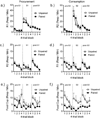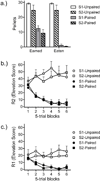Effects of outcome devaluation on instrumental behaviors in a discriminated heterogeneous chain
- PMID: 28045296
- PMCID: PMC5215848
- DOI: 10.1037/xan0000119
Effects of outcome devaluation on instrumental behaviors in a discriminated heterogeneous chain
Abstract
Operant behavior often takes place in a sequence, or chain, of linked responses that lead to a reinforcer. We have recently studied rats performing a discriminated heterogeneous behavior chain that involves the presentation of a discriminative stimulus (e.g., a panel light) to set the occasion for a procurement behavior (e.g., a lever press) that leads to a second stimulus (e.g., a second panel light) that indicates that a consumption response (e.g., a chain pull) will be reinforced. The present study assessed the role played by a representation of the reinforcer in controlling the performance of the responses in this chain. After acquisition of the chain, rats received a reinforcer devaluation treatment in the form of repeated paired, or unpaired, presentations of the food-pellet outcome and lithium-chloride illness. Once paired rats came to reject the pellets, half the animals in each group were tested on procurement, and the other half were tested on consumption. Neither response was affected by the outcome devaluation treatment, although entries into the food cup were suppressed. Combined with other results, the findings suggest that the "goal" for goal-directed procurement responding in a discriminated heterogeneous chain may be the consumption response rather than the primary reinforcer. (PsycINFO Database Record
(c) 2017 APA, all rights reserved).
Figures


Similar articles
-
Factors that influence the persistence and relapse of discriminated behavior chains.Behav Processes. 2017 Aug;141(Pt 1):3-10. doi: 10.1016/j.beproc.2017.04.009. Epub 2017 Apr 24. Behav Processes. 2017. PMID: 28449946 Free PMC article. Review.
-
Extinction and the associative structure of heterogeneous instrumental chains.Neurobiol Learn Mem. 2016 Sep;133:61-68. doi: 10.1016/j.nlm.2016.06.005. Epub 2016 Jun 11. Neurobiol Learn Mem. 2016. PMID: 27296700 Free PMC article. Review.
-
Contextual control of chained instrumental behaviors.J Exp Psychol Anim Learn Cogn. 2016 Oct;42(4):401-414. doi: 10.1037/xan0000112. Epub 2016 Sep 5. J Exp Psychol Anim Learn Cogn. 2016. PMID: 27598060 Free PMC article.
-
Extinction of chained instrumental behaviors: Effects of procurement extinction on consumption responding.J Exp Psychol Anim Learn Cogn. 2015 Jul;41(3):232-46. doi: 10.1037/xan0000064. Epub 2015 Apr 27. J Exp Psychol Anim Learn Cogn. 2015. PMID: 25915751 Free PMC article.
-
Reduction of instrumental discrimination performance by post-conditioning devaluation of discriminative stimulus: the effects of novelty in reinforcing outcome and extended training.Behav Processes. 2006 Jul;73(1):49-61. doi: 10.1016/j.beproc.2006.02.002. Epub 2006 Mar 6. Behav Processes. 2006. PMID: 16564649
Cited by
-
Factors that influence the persistence and relapse of discriminated behavior chains.Behav Processes. 2017 Aug;141(Pt 1):3-10. doi: 10.1016/j.beproc.2017.04.009. Epub 2017 Apr 24. Behav Processes. 2017. PMID: 28449946 Free PMC article. Review.
-
Delineating anticipatory arousal from reward consumption: evaluating fixed-intervals in cocaine seeking-taking response chains.Psychopharmacology (Berl). 2025 Mar;242(3):593-615. doi: 10.1007/s00213-024-06711-9. Epub 2024 Nov 8. Psychopharmacology (Berl). 2025. PMID: 39511030 Free PMC article.
-
Extinction and the associative structure of heterogeneous instrumental chains.Neurobiol Learn Mem. 2016 Sep;133:61-68. doi: 10.1016/j.nlm.2016.06.005. Epub 2016 Jun 11. Neurobiol Learn Mem. 2016. PMID: 27296700 Free PMC article. Review.
-
Maintaining performance in searching dogs: Evidence from a rat model that training to detect a second (irrelevant) stimulus can maintain search and detection responding.Behav Processes. 2018 Dec;157:161-170. doi: 10.1016/j.beproc.2018.09.012. Epub 2018 Sep 28. Behav Processes. 2018. PMID: 30273753 Free PMC article.
-
Goal-direction and habit in human and nonhuman behavioral sequences (behavior chains).J Exp Psychol Anim Learn Cogn. 2025 Apr;51(2):73-91. doi: 10.1037/xan0000395. J Exp Psychol Anim Learn Cogn. 2025. PMID: 40193516
References
-
- Adams CD. Variations in the sensitivity of instrumental responding to reinforcer devaluation. Quarterly Journal of Experimental Psychology. 1982;34B:77–98.
-
- Balleine BW. The role of incentive learning in instrumental performance following shifts in primary motivation. Journal of Experimental Psychology: Animal Behavior Processes. 1992;18:236–250. - PubMed
-
- Balleine BW, Garner C, Gonzalez F, Dickinson A. Motivational control of heterogeneous instrumental chains. Journal of Experimental Psychology: Animal Behavior Processes. 1995;21:203–217.
-
- Balleine BW, Paredes-Olay C, Dickinson A. Effects of Outcome Devaluation on the Performance of a Heterogeneous Instrumental Chain. International Journal of Comparative Psychology. 2005;18:257–272.
MeSH terms
Substances
Grants and funding
LinkOut - more resources
Full Text Sources
Other Literature Sources

